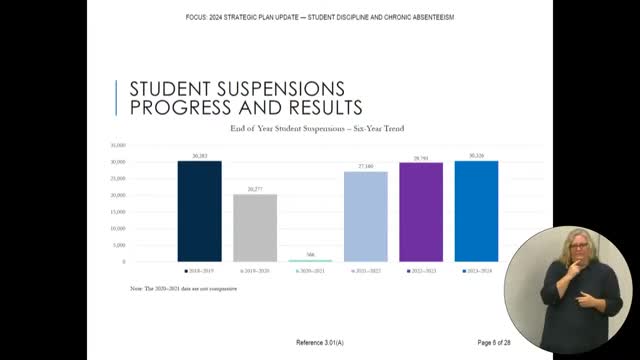Data reveals alarming rise in school suspensions
August 08, 2024 | CLARK COUNTY SCHOOL DISTRICT, School Districts, Nevada
This article was created by AI summarizing key points discussed. AI makes mistakes, so for full details and context, please refer to the video of the full meeting. Please report any errors so we can fix them. Report an error »

In a recent government meeting, officials presented a comprehensive analysis of school suspension and expulsion data, revealing significant trends and areas of concern within the district's disciplinary practices.
The report highlighted a notable increase in suspensions during the 2023-24 school year, with a total of 535 more suspensions compared to the previous year, marking a 1.8% rise. However, a deeper dive into the data showed that through the third quarter of the year, suspensions had actually decreased by 800, or 3.5%, compared to the same period in the prior year. This sharp contrast indicates a troubling spike in the fourth quarter, prompting officials to investigate the underlying causes with school supervisors.
Suspension rates varied significantly across educational levels. High schools reported a substantial decrease of 25% in suspensions through Q3, totaling 7,202, while middle schools experienced a 12% increase, reaching 12,276 suspensions. By the end of the year, high schools maintained an overall reduction of 18% in suspensions, whereas middle schools saw a total of 17,000 suspensions, reflecting a 16% increase from the previous year. Elementary schools remained relatively stable, with a slight increase of about 10%.
The meeting also addressed discretionary expulsions, which are mandatory for weapon-related offenses but optional for other infractions. The district recorded approximately 120 fewer discretionary expulsions than the previous year, an 8% decrease. Notably, this trend continued through the first three quarters, with a 12% reduction in discretionary expulsions compared to the same timeframe in the previous year. This suggests that schools are increasingly opting to keep students within their communities rather than resorting to expulsions.
Discretionary expulsions also showed a positive trend across student groups, with a 12% decrease for African American students and a 6% decrease for Hispanic students by the end of the year. However, the overall increase in suspensions during Q4 raised concerns about the effectiveness of current disciplinary measures, particularly in middle schools.
Officials emphasized the need to focus efforts on middle school discipline strategies, aiming to replicate the successful practices observed in high schools. The meeting concluded with a commitment to refine data presentation methods for better comparison with other districts, acknowledging the challenges posed by varying disciplinary coding practices.
The report highlighted a notable increase in suspensions during the 2023-24 school year, with a total of 535 more suspensions compared to the previous year, marking a 1.8% rise. However, a deeper dive into the data showed that through the third quarter of the year, suspensions had actually decreased by 800, or 3.5%, compared to the same period in the prior year. This sharp contrast indicates a troubling spike in the fourth quarter, prompting officials to investigate the underlying causes with school supervisors.
Suspension rates varied significantly across educational levels. High schools reported a substantial decrease of 25% in suspensions through Q3, totaling 7,202, while middle schools experienced a 12% increase, reaching 12,276 suspensions. By the end of the year, high schools maintained an overall reduction of 18% in suspensions, whereas middle schools saw a total of 17,000 suspensions, reflecting a 16% increase from the previous year. Elementary schools remained relatively stable, with a slight increase of about 10%.
The meeting also addressed discretionary expulsions, which are mandatory for weapon-related offenses but optional for other infractions. The district recorded approximately 120 fewer discretionary expulsions than the previous year, an 8% decrease. Notably, this trend continued through the first three quarters, with a 12% reduction in discretionary expulsions compared to the same timeframe in the previous year. This suggests that schools are increasingly opting to keep students within their communities rather than resorting to expulsions.
Discretionary expulsions also showed a positive trend across student groups, with a 12% decrease for African American students and a 6% decrease for Hispanic students by the end of the year. However, the overall increase in suspensions during Q4 raised concerns about the effectiveness of current disciplinary measures, particularly in middle schools.
Officials emphasized the need to focus efforts on middle school discipline strategies, aiming to replicate the successful practices observed in high schools. The meeting concluded with a commitment to refine data presentation methods for better comparison with other districts, acknowledging the challenges posed by varying disciplinary coding practices.
View full meeting
This article is based on a recent meeting—watch the full video and explore the complete transcript for deeper insights into the discussion.
View full meeting